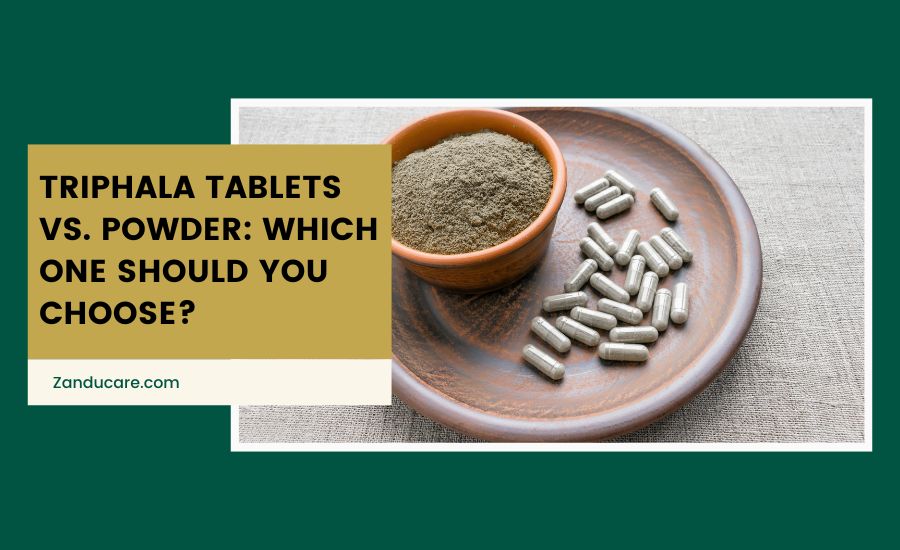Key Highlights:
- Convenience: Tablets are easy to use and portable; powder requires preparation but stays true to Ayurvedic traditions.
- Taste: Tablets are tasteless, while powder has a strong, bitter flavor.
- Absorption: Powder absorbs faster, offering quicker effects; tablets take longer to break down.
- Shelf Life: Tablets last longer; powder needs careful storage.
- Dosage: Powder allows flexible dosing; tablets provide consistent, fixed amounts.
Triphala, a staple in Ayurvedic medicine, is celebrated for its detoxifying and rejuvenating properties. Comprising three potent herbs—Amalaki (Indian gooseberry), Haritaki, and Bibhitaki—Triphala has been used for centuries to support digestion, immunity, and overall health. With its growing popularity in modern wellness, Triphala is available in two main forms: tablets and powder. This article aims to help you decide which form best suits your needs by comparing their features, benefits, and limitations.
Did You Know?
- Triphala, a blend of three fruits, has been used in Ayurveda for centuries to boost digestion and immunity.
- Powder absorbs faster but has a bitter taste, while tablets are tasteless and convenient.
- Tablets have a longer shelf life, lasting up to two years, unlike the shorter lifespan of powder.
- Powder allows flexible dosing, while tablets offer fixed, pre-measured amounts.

Triphala is a cornerstone herbal formulation in the ancient Indian system of medicine known as Ayurveda. It has been used for centuries to promote health and well-being. Triphala contains three medicinal fruits that each contribute unique therapeutic properties:
Amalaki (Emblica officinalis): The Indian gooseberry is an important source of vitamin C and contains high levels of antioxidants. It supports immunity, aids digestion, and contributes to skin, hair, and eye health. The cooling nature of Amalaki helps balance all three doshas in Ayurveda - vata, pitta, and kapha.
Haritaki (Terminalia Chebula): In Ayurveda, Haritaki is known as the "king of medicines." It has strong rejuvenating and laxative qualities. It promotes gastrointestinal motility to relieve constipation while also helping to eliminate toxins and strengthen organ function. The astringent taste helps tone tissues. Haritaki balances vata and kapha doshas.
Bibhitaki (Terminalia Belerica): This herb bolsters respiratory, digestive, and circulatory functions. It's particularly effective at alleviating kapha imbalances like congestion, excess mucus, and inflammation. The bitter and astringent qualities of Bibhitaki make it an excellent digestive aid as well. It helps balance kapha and pitta doshas.
Together, this "three fruit" blend synergistically provides a wide array of therapeutic actions. Triphala is most commonly taken as a churna powder but also comes in capsule, tablet, and liquid extract forms. It supports many major systems, including the digestive, respiratory, urinary, circulation, and immune systems. Triphala is considered safe for long-term use and is valued in Ayurveda for promoting overall health and wellness.
Forms of Triphala: Tablets and Powder

Triphala is primarily available in two forms: powder (churna) and tablets. Each form has distinct characteristics tailored to different preferences and lifestyles.
While tablets offer convenience, powder remains closer to traditional Ayurvedic practices. Both forms retain the essential properties of Triphala, but their efficacy and usage differ.
Triphala Tablets vs Powder: Key Differences
|
Aspect |
Triphala Tablets |
Triphala Powder |
|
Convenience |
Pre-made, easy to consume. No preparation is required. |
Requires mixing with water or other liquids. |
|
Portability |
Compact and easy to carry, ideal for travel. |
Bulky and less convenient for travel. |
|
Preparation Time |
Ready to use; no extra time needed. |
It needs preparation; it takes time to mix and consume. |
|
Dosage Control |
Fixed dosage in each tablet, ensuring consistency. |
Dosage can be customised based on individual needs. |
|
Taste |
Tasteless, as the coating masks the bitter flavour. |
Strong, bitter taste that some may find unpleasant. |
|
Absorption Rate |
Slower absorption as tablets need to break down first. |
Absorbs quickly when mixed and consumed directly. |
|
Traditional Use |
Modern adaptation, less traditional. |
Aligned with traditional Ayurvedic practices. |
|
Efficacy |
Effective, but may contain binders or fillers. |
Pure and unprocessed, often more potent. |
|
Shelf Life |
Longer shelf life due to minimal exposure to air. |
Shorter shelf life; requires airtight storage. |
|
Cost |
Generally more expensive due to processing. |
Often cheaper as it is less processed. |
|
Usage Preference |
Ideal for busy lifestyles or beginners. |
Suitable for those seeking a more authentic experience. |
Triphala Tablets: Features, Benefits, and Limitations
Below are the features, benefits and limitations of Triphala:
1. Features Explained
- Pre-measured doses: Triphala tablets contain a standardized amount of the Triphala powder in each tablet, typically 500mg or 1,000mg. This allows for consistent dosing and ease of use.
- Pressed into pills: The Triphala powder is compressed under pressure to form it into pill form. This makes the tablets easier to package, store, and swallow.
- Coated: Most Triphala tablets have a thin coating that serves dual purposes—it makes them easier to swallow as they slide down smoothly, and it also protects the herbs from light, air, or moisture, which could degrade them over time. Common coatings used include gelatin or vegetable cellulose.
2. Limitations Explained
- May contain binders/fillers: To keep the tablets' shape, manufacturers often add additional ingredients like magnesium stearate, silicon dioxide, or pre-gelatinized starch. Those seeking a pure herbal supplement may wish to avoid these extra additives.
- Slightly reduced potency: The high heat and pressure involved in manufacturing tablets may subtly damage or degrade some of the delicate phytochemicals naturally present in the Triphala herbs, slightly reducing their therapeutic effects.
- Delayed absorption: Due to the solid mass and coating, tablets take longer to disintegrate and dissolve than powder once ingested. This means absorption is delayed and onset of effects is slower compared to Triphala powder or capsules.
3. Benefits Explained
- Convenient: Tablets require no measuring or mixing; you can simply swallow them directly, making supplementation extremely convenient.
- Portable: Their small size and lack of mess make Triphala tablets easy to drop in a purse or bag and take with you anywhere.
- Long shelf life: Properly stored, the tablet form allows Triphala to remain viable for up to 2 years. The powder loses potency faster.
- Tasteless: Many people find the strong astringent taste of Triphala powder unpalatable. The coating masks any unpleasant flavour.
Also, check:
Triphala Powder: Features, Benefits, and Limitations

Here are the Triphala powder features, benefits, and limitations:
1. Features
- Raw dried fruit blend: Triphala powder contains the three medicinal fruits - Amalaki, Haritaki, and Bibhitaki - in their dried, unprocessed form, ground into a fine churna powder.
- Unadulterated composition: Unlike tablets, the powder does not contain any additional ingredients like fillers, binders, or coatings. It is simply pure dried fruit powder.
- Traditional preparation: Following ancient Ayurvedic wisdom, the fruits are harvested at peak ripeness, precisely dried, and freshly ground to retain potency in their natural state.
2. Limitations
- Unpleasant taste: The powder's astringent, bitter taste can be intensely unpalatable and difficult to consume for some individuals. Mixing it with sweeteners may be necessary.
- Manual preparation: Unlike convenient tablets, Triphala powder requires measuring out and manually mixing with water, honey, or other liquids prior to ingestion. This may not suit those with busy lifestyles.
- Shorter shelf life: Without preservatives or protective coatings, the powder is more vulnerable to contamination, moisture, heat, or light exposure, leading to faster degradation within several months if improperly stored.
3. Benefits
- Rapid dissolution: When mixed as a liquid solution, the fine powder form allows for quicker disintegration and absorption compared to solid tablets, leading to faster-acting effects.
- Flexible dosing: With powder, you can fine-tune the dosage to meet your personal tolerances and therapeutic goals, and you are not restricted to fixed tablet strengths.
- Greater authenticity: Prepared using time-honoured Ayurvedic methods, the powder form offers increased fidelity to traditional practice for heightened effectiveness.
Conclusion
Triphala, whether in tablet or powder form, is a versatile and effective herbal remedy with numerous health benefits. Tablets are ideal for convenience and portability, while powder aligns with traditional practices and offers faster results. Your choice depends on your lifestyle, taste preferences, and health needs. Regardless of the form, incorporating Triphala into your routine can significantly enhance your overall well-being. Always consult a healthcare professional for personalised guidance.
FAQs
1. What are the key ingredients in Triphala?
The three key medicinal fruits in Triphala are Amalaki (Indian gooseberry), Haritaki, and Bibhitaki. Each fruit provides unique therapeutic properties and balances different doshas.
2. What are some of the benefits of taking Triphala?
Some of the main benefits include improved digestion, toxin elimination, immune support, antioxidant effects, respiratory and circulatory aid, and overall well-being. It helps balance all three Ayurvedic doshas.
3. What are the main forms that Triphala comes in?
The two primary forms are tablets (compressed pills) and churna powder made directly from dried fruits. It is also available as capsules or liquid extracts.
4. What makes Triphala tablets convenient to use?
Tablets are pre-measured into consistent doses, require no preparation, are portable and travel-friendly, tasteless, and have a longer shelf life compared to the powder.
5. How do Triphala tablets differ from the powder?
The main differences are that tablets may contain binders, have reduced potency, and have slower absorption. The powder aligns more closely with traditional Ayurvedic methods, provides flexible dosing, and faster effects.
6. Does Triphala powder have an unpleasant taste?
Yes, Triphala powder has an intensely bitter, astringent taste that some people find too unpleasant to tolerate. Tablets eliminate this taste. Mixing the powder with sweeteners can help.
7. What’s the best way to take Triphala powder?
The powder must be measured out and mixed into water, honey, ghee or milk before drinking. This liquid solution allows faster absorption compared to swallowing the powder directly.
8. How should Triphala powder be stored?
Unlike tablets, the powder is vulnerable to contamination and degradation. It requires proper storage in an airtight glass jar, away from moisture, heat, and sunlight.
References:
- Triphala, a blend of three fruits, has been used in Ayurveda for centuries to boost digestion and immunity. (https://www.researchgate.net)
- The Indian gooseberry is an important source of vitamin C and contains high levels of antioxidants(https://www.researchgate.net).
- Effective, but may contain binders or fillers (https://pmc.ncbi.nlm.nih.gov/articles/PMC5567597/)







